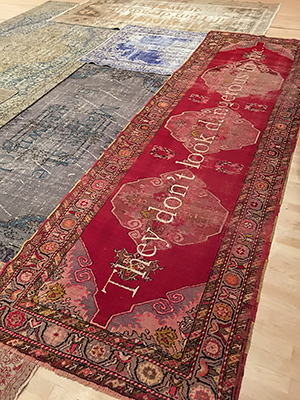Photo Corners headlinesarchivemikepasini.com
![]()
A S C R A P B O O K O F S O L U T I O N S F O R T H E P H O T O G R A P H E R
![]()
Enhancing the enjoyment of taking pictures with news that matters, features that entertain and images that delight. Published frequently.
Carolyn Drake's 'Wild Pigeon'




26 March 2018
Now showing in SFMOMA's New to the Collection room for its new acquisitions, Carolyn Drake's Wild Pigeon reaches beyond documentary photography to fine art to tell the story of the Uyghurs of western China.

Carolyn Drake. From 'Wild Pigeon'.
The Magnum photographer and current resident of Vallejo (which is also the name of her current working project) visited the remote Xinjiang Uyghur Autonomous Region many times between 2007 and 2013. She saw the ancient Uyghur neighborhoods demolished to make way for modern Chinese tracts, which led to riots iin 2009 during which hundreds died.

If you didn't hear about that's because the Uyghurs not allowed to talk about it. Uyghurs talk to foreigners at the risk of police interrogation. Foreign journalists are followed and frustrated.
What about photography? Well, the religious beliefs of some Uyghurs prevent them from depicting living beings because only Allah has the power to give life. So not even smartphone photography told their story.
But Drake had an idea.
She toured the region, staying in the villages and cities along the Taklamakan desert with a box of prints, a pair of scissors, colored pencils and a sketchbook. She invited the Uyghurs to draw on the prints, reassemble them and use their own crafts on the photos.
The result was a photobook Drake published in 2014 called Wild Pigeon, taking its title from the writer Nurmuhemmet Yasin's story of the same name, which tells the Uyghur story as an allegory set among pigeons. Yasin was arrested in 2004 after the story's publication.
In the story, the wild pigeon's mother explains the situation to him:
Mankind is pressing in on us, little by little, taking up what once was entirely our space. They want to chase us from the land we have occupied for thousands of years and to steal our land from us. They want to change the character of our heritage -- to rob us of our intelligence and our kinship with one another. Strip us of our memory and identity. Perhaps in the near future, they will build factories and high-rises here and the smoke that comes from making products we don't need will seep into the environment and poison our land and our water. Any rivers that remain won't flow pure and sweet as they do now but will run black with filth from the factories.
Last year, SFMOMA acquired 32 original collages from the set of photographs, drawings, and embroideries made in collaboration with Uyghurs. They're on display along with additional works by Drake, textile artist Coulter Fussell and sound designer Reiko Yamada.

Fussell's rugs embroider sentences from Yasin's story that disappearing into the weave to reflect their subversive nature. In our shot below you can read the phrase uttered by the young pigeon, "They don't look dangerous to me," in the red rug but the other pieces are much more subtle.
Yamada's soundscape accompanying the installation (available on SFMOMA's app for iOS, also available on audio devices you can rent at the museum) features conversations between Drake and the people she photographed and collaborated with.
Because most Uyghurs are barred from traveling outside China, they often have their portraits taken at mobile photo studios against backdrops depicting foreign landscapes. At least the non-Muslim Uyghurs, that is.
Some of those images appear in the show. And they informed our appreciation of Drake's unusual use of photography.

Fussell's Rugs. Quoting Yasin's story.
At first it was disturbing to see prints drawn on with crayons or cut up to make what looked like scrapbook pages. But the more we knew about the story, the more it made sense.
One "scrapbook page," for example, pasted photos of a two children holding a tree trunk with large leaves growing from it. The imaginary leaves were embroidered in gold thread. A promise of life along the desert.
Another depicted an old man surrounded by unattainable riches: a home, food, livestock, a motorcycle, a car. His hands full.
These were the collaborations, apparently.
Drake also included some of her own straight shots showing the life of the Uyghurs, including the one of the shoeless peach vendor above. As he practices an ancient profession, he is dwarfed by the modern concrete highway on-ramp destroying the world the Uyghurs have known.
It's not a well-documented exhibit, making it hard to appreciate the connection between the rugs and the images. Or even to appreciate why many of the prints have been drawn on and by whom.
But once you know the story, the effect of seeing these images is profound. It's as if wild pigeons could speak or silent screams communicate.
SFMOMA has posted the set of images online. And Magnum has a page devoted to the project.